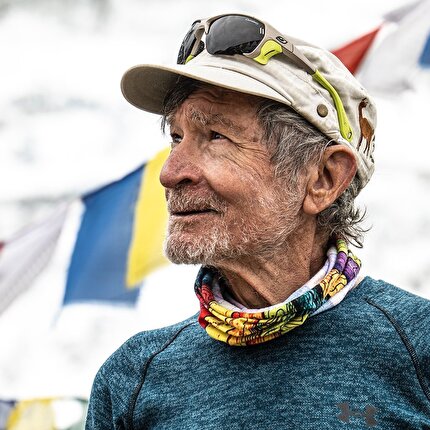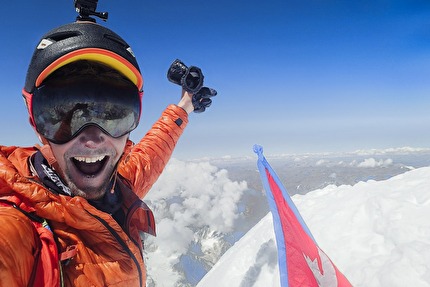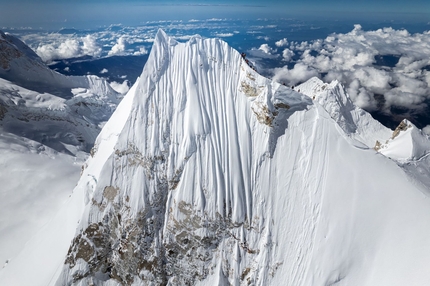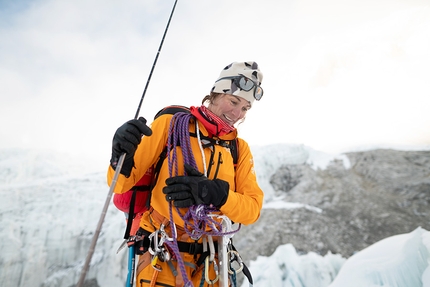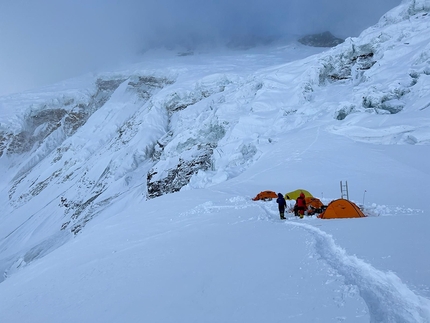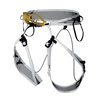Russians climb big new route on Manaslu Southwest Face

 1 / 13
1 / 13 archive Andrey Vasilyev / Sergey Kondrashkin / Natalia Belyankina
archive Andrey Vasilyev / Sergey Kondrashkin / Natalia Belyankina
In the spring of 1972 a Tyrolean expedition opened a new route on the southwest face of Manaslu. The line, later known as the Tyrolean or Messner route, avoids the center of the wall and gains the ridge to the west, following an ice ramp that leads to the summit plateau. Although Reinhold Messner summited, on his own on 25 April, the climb ended in tragedy when Franz Jäger and Andi Schlick disappeared during the descent, leaving Messner and his partners to fight their way back through a storm. The route became both a milestone and a warning.
More than fifty years later, a Russian team approached the same side of the mountain, aiming for a new line on the face. They would later descend by the old Tyrolean route, closing a historical loop across the southwest wall.
The autumn of 2024 two Russian teams were climbing two different eight-thousanders. On Dhaulagiri the season ended in tragedy. A sequence of small misjudgments, delays, weather, exhaustion, took the lives of five climbers. Their disappearance sent a quiet shock through the Russian mountaineering community, a reminder of how narrow the space is between persistence and loss.
At the same time Andrey Vasilyev’s team was on Cho Oyu, attempting the Yefimov Route on the east ridge, without oxygen or Sherpas. They did not reach the summit, but the experience proved decisive. Weeks of work at high altitude, days spent above seven thousand meters, and the discipline of stopping when progress became unsafe gave them a deep understanding of endurance and judgment. What seemed a failure then became preparation. On Manaslu, that lesson would keep them alive.
The team came together slowly, and it was unclear who would go. In the end there were five: Andrey Vasilyev, Sergey Kondrashkin, Kirill Eizeman, Natalia Belyankina, and Vitaly Shipilov.
The acclimatisation stage followed the normal route of Manaslu. From the start of the trek to the summit it took only fifteen days. The guys saved money by living in Samagaon instead of a serviced base camp, walking an extra kilometer of elevation each time. "Less comfort, but better recovery," Vasilyev noted.
During acclimatisation they managed to take several photographs of the southwest side of the mountain, showing the glacier between Tulagi and Manaslu and the ridge where the 1972 Austrian route runs. The plan for the second stage was to traverse there and attempt a new line. A drone reconnaissance failed when it crashed on the glacier, leaving them to explore the face the old way, step by step and without knowing what lay ahead.
On October 12, 2025, they left Samagaon for the southwest side, carrying twelve to fourteen days of food. Their goal was clear: climb in one continuous push, without oxygen, fixed camps, or resupply.
By October 13 they stood below the icefall, watching where the ice broke and fell, searching for a safe line. The next day they moved higher, weaving between crevasses, testing routes that ended in dead walls of seracs. On the 15th they finally found a passage through the maze and reached the base of the face. The following night they camped at the end of the slope at about 6300 meters, their last easy ground before the wall.
At dawn on October 17 they started up the southwest face. The line followed steep snowfields and mixed sections, never extreme but unrelenting. They climbed to 6900 meters and pitched their tent. "Good conditions, a beautiful line," Vasilyev wrote that evening. "We’re tired, but compared to Cho Oyu, we feel fresh."
Natalia Belyankina later wrote, "My team stopped seeing me as special or fragile long ago. They just joke that now we have someone who can’t get frostbite on her toes." In 2022, after frostbite, she had several toes amputated and had to learn to walk again. "Climbing, breathing, watching, laughing together. Maybe that’s what alpinism really is."
By October 19 the team had reached 7050 meters, the last possible campsite before the upper wall. "Tomorrow, ten rope lengths to the ridge." They did not reach it. That night they dug into the snow and sat through the wind in a shallow trench, unable to sleep.
The next morning brought a short message: "Congratulations to the French Benjamin and Nicolas. That’s strong." The news of Vedrines and Jean’s success on Jannu East reached them through InReach.
Their own climb stretched endlessly. "A day apart from everything, no sleep, no rest," Vasilyev reported. "We are exhausted, the pace is slower. The terrain is fine." Kirill Eizeman added, "Two nights without sleep, it’s hard but at least the acclimatization is good."
The tone of their messages remained steady, almost detached, as if survival had its own rhythm. But for those reading from below, the signs of exhaustion, typos, halting phrases, a schedule that fell behind by days, were beginning to show.
On October 21 the team finally reached the ridge at 7700 meters. "Steep terrain, then the classic route on foot." At midnight they prepared for the final push. At 19:40 Nepal time on October 22, the report came through: "Summited. Just back in the tent. Brutal. The wind on top is insane."
Five climbers on the roof of Manaslu, alone, after eleven days on the mountain. A clean new line drawn across a face where almost no one goes.
Evening settled heavy. "We’ll descend slowly. There’s a long way to base camp." Below, the Tyrolean route waited seven hundred meters of unknown ground. "It’s dangerous," Vasilyev wrote. "We’re all healthy, just wiped out. But when it’s time to go down, strength always comes."
The descent began under worsening weather and growing fatigue. After summiting on October 22, the team spent a cold, sleepless night just below the top, waiting for morning light to move. On October 23 they started down toward the Tyrolean route, the only known descent on their side of the mountain. The fog was dense, visibility almost zero, and by evening they stopped to bivouac at about 7800 meters. The following morning the sky cleared, and they began the long series of rappels that would take them down the southwest ridge. Anchors in unstable snow demanded time and care, each one dug, tested, and rebuilt before the next descent. By nightfall they had completed twenty rappels, losing nearly a thousand meters of height before stopping on a narrow platform to bivouac again.
Food supplies were almost gone, reduced to the last portions of tea and chocolate. Over the next two days they continued across the glacier and down through the icefall, recovering their old landmarks. The route was no longer the same: snow had melted, crevasses widened, and several times they were forced to search for new passages through the broken terrain. Late on October 26 they reached the base of the wall, descending the final ice steps and the Bergschrund to solid ground.
Four days after the summit they were back below the face. The descent had cost almost as much effort as the climb itself, but it ended without injury or loss. Exhausted and underfed, the five climbers walked the last stretch in silence, following their InReach track across the glacier. When they finally stopped, the realisation came slowly, after eleven days on the wall and fifteen on the mountain, they had completed the first ascent of a new route on the southwest face of Manaslu and returned alive.
And Vasilyev, always concise: "We didn’t climb the grandest line. But we chose the right one."
- Anna Piunova, Chamonix
Info: www.mountain.ru



 Copia link
Copia link

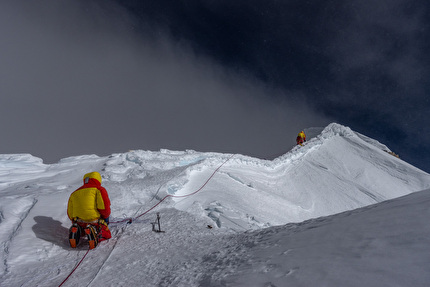
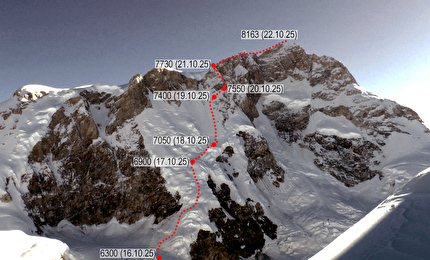
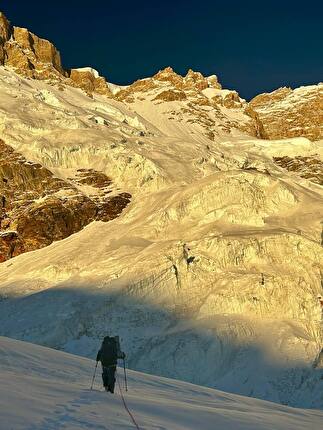
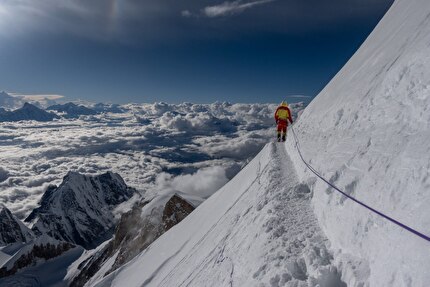
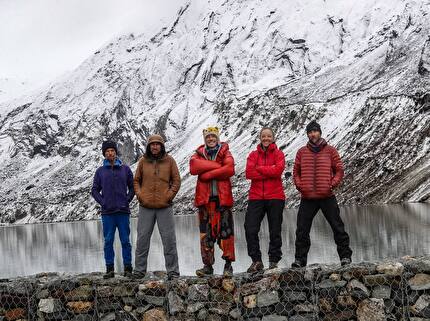
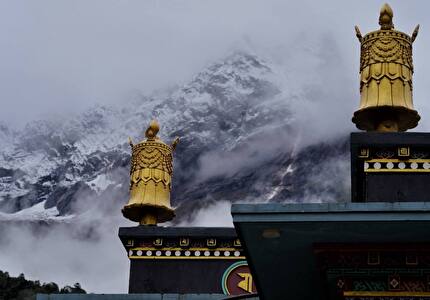

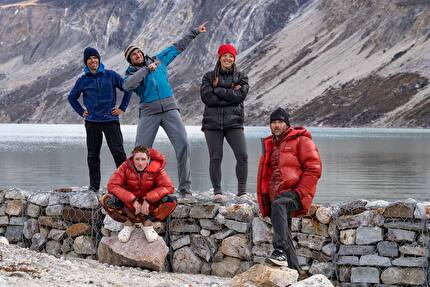
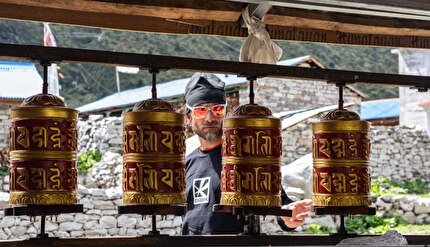



 See all photos
See all photos